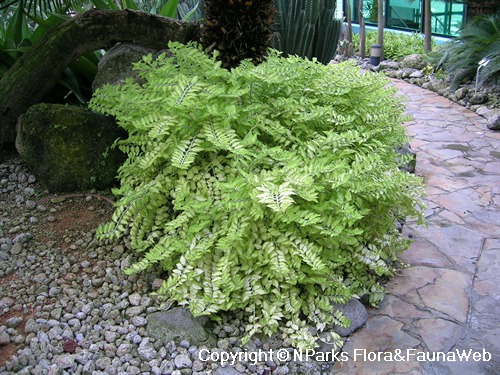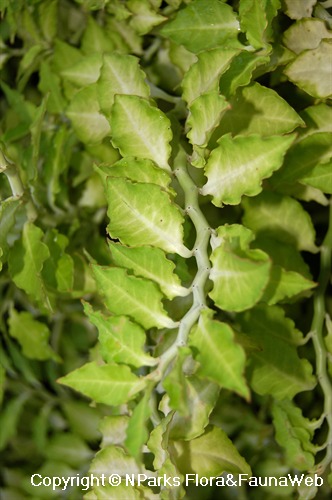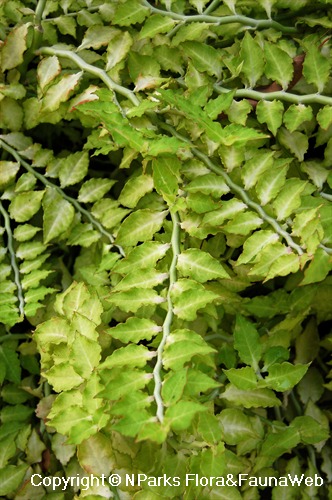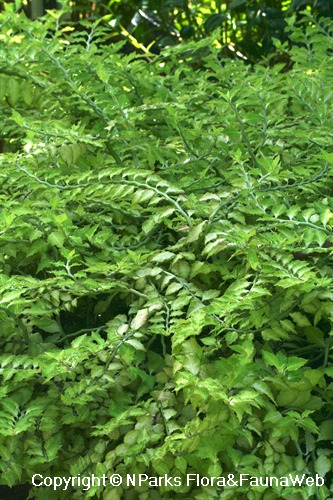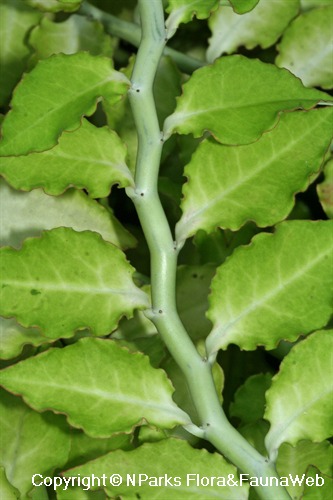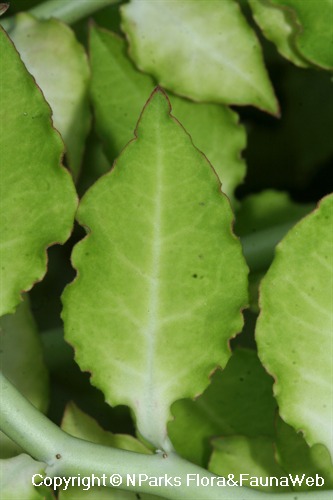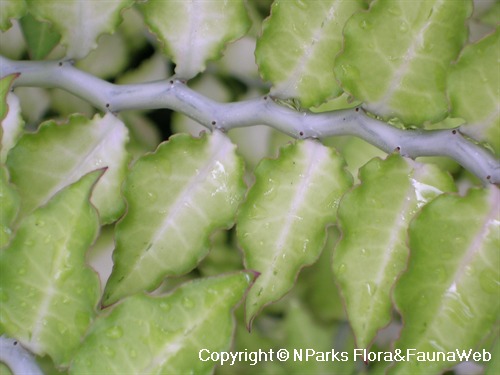
Back
Euphorbia tithymaloides subsp. smallii 'Albino'
| Family Name: | Euphorbiaceae |
| Synonyms: | Pedilanthus tithymaloides subsp. smallii 'Albino' |
| Common Name: | Zigzag Plant, Devil's Backbone |
Name
Classifications and Characteristics
| Plant Division | Angiosperms (Flowering Seed Plants) (Dicotyledon) |
|---|---|
| Plant Growth Form | Herbaceous Plant, Creeper |
| Lifespan (in Singapore) | Perennial |
| Mode of Nutrition | Autotrophic |
| Plant Shape | Shrubby |
Description and Ethnobotany
| Growth Form | A peculiar, robust, small to medium-sized, moderately fast-growing, somewhat erect shrub that possesses distinctive, strong, stout, succulent zig-zag stems and brightly variegated foliage with a beautiful mix of green, white and yellow. |
|---|---|
| Foliage | Leaves simple, alternate, waxy, lanceolate (lance head-shaped), with acuminate (tapering to a point) tips and sessile (attached directly at the base; not having a stalk) bases, glabrous, about 4 to 7 cm long and 3 to 4 cm wide, with undulated to entire margins, midribs diffusing from white to yellow to green. |
| Others - Plant Morphology | Stem: Stems somewhat erect to spreading, stout, succulent, darker green (usually serve as the photosynthetic organ in the absence of deciduous leaves), zig-zag growing, glabrous (smooth; not rough or hairy), often having a raised, nearly ledge-like swellings subtending its foliage. Flower: Flowers a cyathium (cup-shaped inflorescence surrounded with a collection of bracts), vary from pink to red. Fruit: Fruits sulcate (grooved or furrowed), 0.5 to 0.6 cm in diameter; seeds subglobose (not entirely spherical), grey-brown, about 0.45 cm long and 0.3 cm wide. |
| Cultivation | Adaptable to a wide range of light conditions, it prefers semi-shade condition with a few good hours of direct sun and the rest of the day with filtered light. Colours on foliage seem to be light dependent, with strong, direct light to generate more suffused pink or red on the foliage. Plant is drought tolerant and defoliation can occur should there be too much a water stress. Prune back occasionally to get a bushier plant. Propagate by cuttings. Caution: Roots, stems and leaves of plant contain toxic juice. Handle with extra care and wear gloves if need be. |
| Etymology | > The genus epithet ‘Euphorbia’ is derived from 'Euphorbus', the Greek physician to Juba II, King of Mauretania. Juba II was treated by a plant (probably the Resin Spurge, Euphorbia resinifera) with powerful medicinal properties, of which he named after his Greek physician 'Euphorbus'. The species epithet ‘tithymaloides’ is derived from the ancient name used by Pliny the Elder to describe a ‘Euphorbia’, ‘Tithymalus’, which resembles the plant. The subspeices epithet ‘smallii' is named after Dr. John Kunkel Small, 20th century American explorer and botanist, who probably collected or described this plant. |
Landscaping Features
| Desirable Plant Features | Ornamental Stems, Ornamental Foliage |
|---|---|
| Landscape Uses | General, Suitable for Rooftops, Flowerbed / Border |
| Thematic Landscaping | Golden Garden, Rockery / Desert Garden |
| Usage Hazard - Cons | Irritant - Sap |
Plant Care and Propagation
| Light Preference | Full Sun |
|---|---|
| Water Preference | Little Water |
| Rootzone Tolerance | Fertile Loamy Soils, Well-Drained Soils, Drought Tolerant, Shallow Media |
| Maintenance Requirements | Moderate |
| Propagation Method | Stem Cutting |
Foliar
| Foliage Retention | Evergreen |
|---|---|
| Mature Foliage Colour(s) | Green, White, Yellow / Golden |
| Mature Foliage Texture(s) | Smooth, Glossy / Shiny, Thick |
| Foliar Type | Simple / Unifoliate |
| Foliar Arrangement Along Stem | Alternate |
| Foliar Venation | Pinnate / Net |
| Foliar Margin | Entire - Wavy / Undulate |
| Leaf Area Index (LAI) for Green Plot Ratio | 4.5 (Shrub & Groundcover - Dicot) |
Non - Foliar and Storage
| Stem Type & Modification | Herbaceous |
|---|---|
| Root Type | Underground (Fibrous Root) |
| Specialised Storage Organ(s) | Aboveground |
Image Repository
Others
| Master ID | 1014 |
|---|---|
| Species ID | 2308 |
| Flora Disclaimer | The information in this website has been compiled from reliable sources, such as reference works on medicinal plants. It is not a substitute for medical advice or treatment and NParks does not purport to provide any medical advice. Readers should always consult his/her physician before using or consuming a plant for medicinal purposes. |

